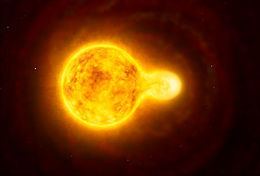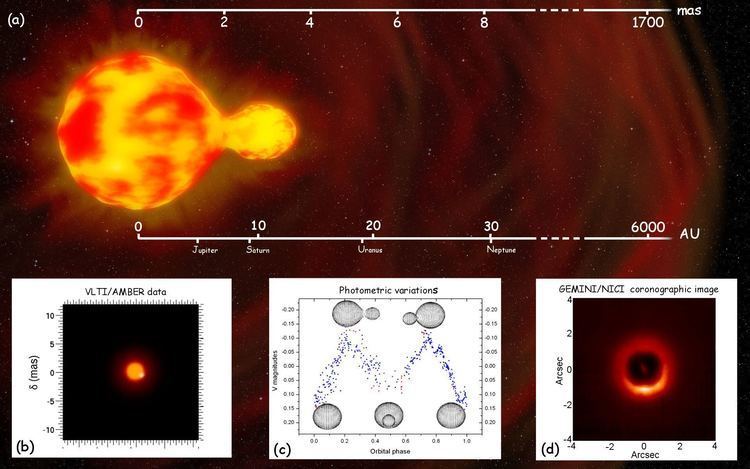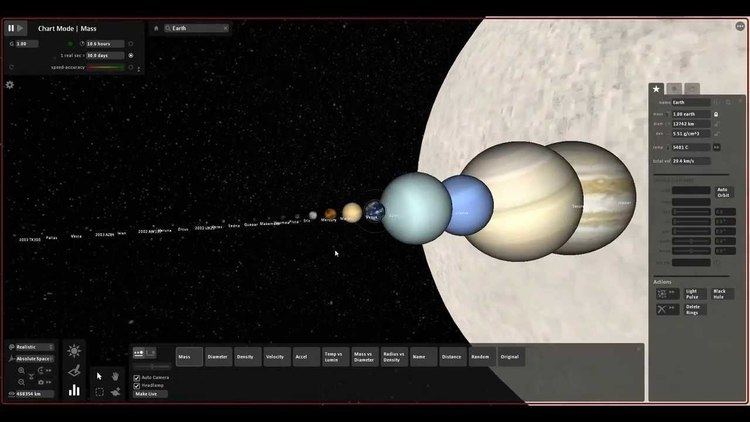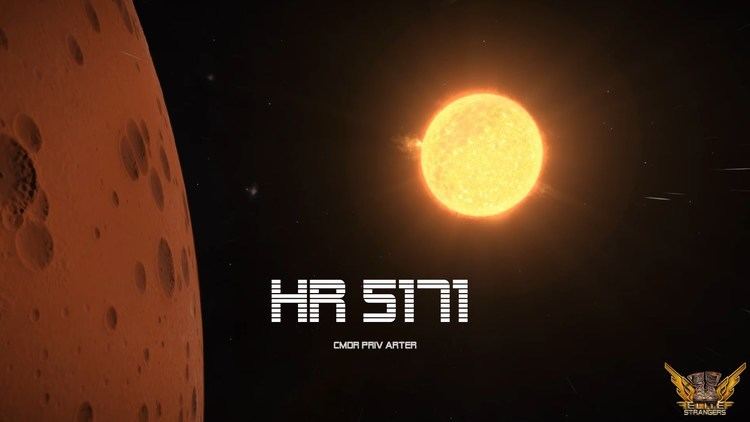Primary Aa Luminosity 316,000 L☉ Constellation Centaurus | Companion Ab Magnitude 6.51 | |
 | ||
Similar Rho Cassiopeiae, UY Scuti, RW Cephei, VX Sagittarii, KW Sagittarii | ||
Artist s impression of the yellow hypergiant star hr 5171 eso
HR 5171, also known as HD 119796 and V766 Centauri, is a triple star system in the constellation Centaurus, around 12,000 light years from Earth. It contains the largest known yellow hypergiant star which is also an eclipsing binary.
Contents
- Artist s impression of the yellow hypergiant star hr 5171 eso
- Zooming in on the yellow hypergiant star hr 5171
- Observational history
- System
- Variability
- Properties
- Evolution
- References
Zooming in on the yellow hypergiant star hr 5171
Observational history

HR 5171 was named by inclusion in the Harvard Revised Catalogue, later published as the Bright Star Catalogue. It was entry #5171, listed at magnitude 6.23 and spectral type K. HR 5171 was catalogued as a double star in 1927.

In 1956 HR 5171 was recorded at magnitude 6.4, spectral type G5p, and profoundly reddened. In 1966 Corben recorded it as magnitude 6.51 and spectral type G5p, and noted it as being variable. A 1969 catalogue records a visual magnitude of 5.85 and a spectral type of A7V, presumably a case of mistaken identity. In 1971, HR 5171A was identified as a G8 hypergiant, reddened by over 3 magnitudes of interstellar extinction and also by half a magnitude of extinction from circumstellar material. In 1979 it was confirmed as one of the brightest known stars with an absolute visual magnitude (MV) of −9.2. The G8 spectral type was adjusted to K0 Ia+ in the revised MK system.

In 1973 HR5171 was formally recognised as variable star V766 in Centauri, based on Corben's 1966 catalogue. At the time it was considered a "cool S Doradus variable", a class including stars such as Rho Cassiopeiae that are now known as the yellow hypergiants. These variables are usually classified as semiregular (SRd) due to variations which are sometimes well-defined, at other times nearly constant, and may show unpredictable fading. A detailed study showed variability in both brightness and spectral type with possible periods developing from 430 days to 494 days. The temperature was calculated to vary from nearly 5,000 K to below 4,000 K.

In 2014, VLTI observations directly determined an unexpectedly large size for HR 5171 and revealed that it is a contact binary. A shell of material around the star has also been directly imaged.
System

The HR 5171 system contains at least three stars. The primary A is an eclipsing binary (components Aa and Ab, or A and C in the Catalog of Components of Double and Multiple Stars) with two yellow stars in contact and orbiting in 1,304 days. The companion has been detected directly by optical interferometry, and is approximately one third the size of the hypergiant primary. The two stars are in the common envelope phase where material surrounding both stars rotates synchronously with the stars themselves.
Component B, 9.4" away, is a B0 supergiant. It is a highly luminous massive star in itself but 3 magnitudes fainter than the yellow hypergiant. At 3.6 kpc, this is a projected separation of 35,000 AU although the actual separation could be larger.
Variability
HR 5171 shows erratic changes in brightness and colour. HR 5171B is apparently stable, with the changes being due to physical changes in the hypergiant star, variations in the envelope, and eclipses between the two close companions.
The primary and secondary eclipses have depths of 0.21 and 0.14 magnitudes respectively at visual wavelengths. The light curve shows almost continuous variation due to the contact nature of the system, but there is a distinct flat bottom to the secondary eclipse where the secondary passes in front of the primary. The shape of the eclipse light curve suggests that the orbit is almost edge on to Earth, and that the secondary is slightly hotter than the primary.
The eclipses occur against a background of intrinsic variations. Statistically, the system has a mean magnitude of 6.54 and average variations of 0.23 magnitude over a period from the middle of the 20th century until 2013, but within this there are decades with relatively little variation and others which are much more active. Three deep minima have been observed, in 1975, 1993, and 2000, with the brightness dropping below 7th magnitude each time for around a year. Colour changes at these minima suggest a transfer of luminosity from the visual to the infrared, either as a result of cooling or recycling by the surrounding envelope. Following the deep minima, smaller brightness peaks are observed. Overall, the variability in brightness has been much stronger since 2000.
The variations in infrared brightness compared to visual brightness correspond quite well to the light curve, suggesting that brightness changes are related to colour or extinction changes, but there has been a secular trend in the B-V colour index. From 1942 until 1982, B-V steadily increased from around 1.8 to 2.6. Since then it has been approximately constant. This does not appear to be related to reddening as it is independent of the visual magnitude, so it suggests a change in the star itself. The most likely change is that the hypergiant has been cooling and increasing in size.
The variations are erratic, but a strong 657-day periodicity was noticed in Hipparcos photometry of HR 5171. More recent variations showed the strongest periodicity at around 3,300 days, but also showed other variation periods including one at 648 days. This persistent periodicity through all other variations is due to the eclipses twice every 1,304 days.
Properties
HR 5171A is the largest known yellow star. It has been calculated to be 1,315 solar radii (568,000,000 mi; 915,000,000 km). If HR 5171A were to be put in the center of the Solar System, it would stretch to a distance of 912,584,500 kilometres (567,053,700 mi), between the orbits of Jupiter and Saturn. It has a volume approximately 2.274 billion times bigger than the Sun.
The star has also been found to be getting larger in size over the time of its examination and is one of the very few stars that have been found to be changing their temperature with difference in size: HR 5171 is getting cooler as it grows. It is classified in the General Catalogue of Variable Stars as a possible S Doradus variable, as well as an eclipsing variable.
Evolution
This type of star has evolved from an initial mass of around 60 times the Sun to a cool hypergiant and is now shedding its remaining outer layers in a series of dramatic explosions, progressively increasing in temperature. It may become a blue supergiant or luminous blue variable before declining in luminosity as a late type Wolf–Rayet star, but may explode as a supernova before that point.
The very high luminosity, extreme size, and mass exchange with the lower mass companion make this an unusual star within a very rare class of stars, but it has been relatively poorly studied until recently.
